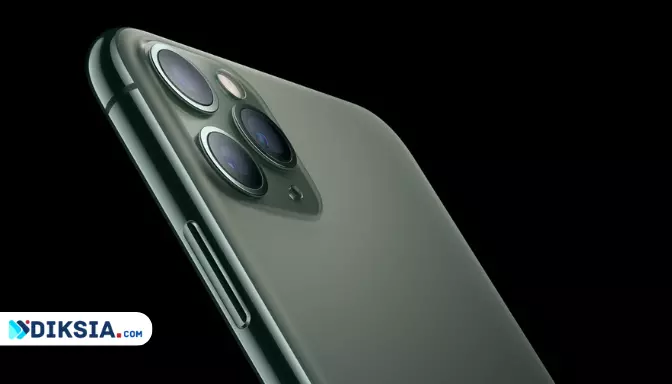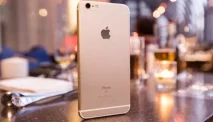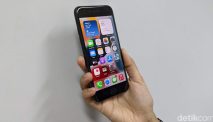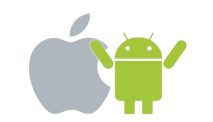The iPhone 11 Pro Max has a large 6.5-inch display that covers almost the entire front of the phone, except for a notch at the top that houses the front camera and the Face ID sensor. The notch is still noticeable, but it does not interfere with the immersive viewing experience. The display has rounded corners that follow a curved design, and the edges of the phone are also slightly curved for a comfortable grip.
The iPhone 11 Pro Max has a triple-camera system on the back, arranged in a square module with a raised bump. The cameras are accompanied by a quad-LED flash and a microphone. The camera bump is a bit prominent and may wobble when placed on a flat surface, but it can be solved by using a case. The cameras are protected by a sapphire crystal lens cover, which is very hard and scratch-resistant.
The iPhone 11 Pro Max has a few physical buttons and ports on the sides. On the right side, there is a side button that can be used to turn on/off the phone, lock/unlock the screen, activate Siri, or make emergency calls. On the left side, there are volume buttons and a ring/silent switch that can be used to mute or unmute the phone. On the bottom, there is a Lightning port for charging and data transfer, and a speaker grille. The phone does not have a 3.5 mm headphone jack, but it comes with a pair of Lightning earphones in the box.
The iPhone 11 Pro Max is rated IP68 for water and dust resistance, which means it can withstand submersion in up to 4 meters of water for up to 30 minutes. However, this does not mean that the phone is waterproof, and Apple does not cover water damage under its warranty. Therefore, it is advisable to avoid exposing the phone to liquids or extreme temperatures.
User Interface
The iPhone 11 Pro Max runs on iOS 13, which is the latest version of Apple’s operating system. iOS 13 offers a smooth and intuitive user interface, with a lot of features and improvements over the previous versions. Some of the notable features of iOS 13 are:
- Dark Mode: A new option that changes the appearance of the system and some apps to a dark theme, which is easier on the eyes and saves battery life.
- Swipe Keyboard: A new way of typing that allows you to swipe your finger across the keyboard to form words, instead of tapping on each letter.
- Photos and Camera: A redesigned Photos app that organizes your photos and videos by days, months, and years, and offers more editing tools and filters. A new Camera app that adds a Night mode for low-light photography, a QuickTake mode for capturing videos without switching modes, and a Portrait Lighting mode for adjusting the lighting effects on your portraits.
- Face ID: A biometric security feature that uses the front camera and the depth sensor to scan your face and unlock your phone, make payments, or access apps. Face ID is faster and more accurate than ever, and works in more angles and orientations.
- Siri: A virtual assistant that can help you with various tasks, such as making calls, sending messages, setting reminders, playing music, getting directions, and more. Siri can also be activated by voice, by saying “Hey Siri”.
- App Store: A platform that allows you to download and update thousands of apps and games, as well as access Apple Arcade, a subscription service that offers over 100 exclusive games.
- Apple Pay: A secure and convenient way of making payments using your phone, either online or in stores that accept contactless payments. You can also use Apple Pay to send and receive money through iMessage, or to pay for public transportation in some cities.
- iCloud: A cloud service that allows you to store and sync your photos, videos, contacts, calendars, notes, reminders, and more across your devices. You can also use iCloud to backup your phone, locate your phone if it is lost or stolen, or share files and folders with others.
- AirDrop: A feature that allows you to wirelessly share files and content with other nearby Apple devices, without using the internet or Bluetooth.
- AirPlay: A feature that allows you to wirelessly stream audio and video from your phone to other compatible devices, such as Apple TV, speakers, or smart TVs.
- CarPlay: A feature that allows you to connect your phone to your car’s infotainment system, and use your phone’s apps and features on the car’s display, such as navigation, music, calls, messages, and more.
The iPhone 11 Pro Max does not have a home button, so it relies on gestures for navigation. Some of the basic gestures are:
- Swipe up from the bottom edge to go to the home screen or access the app switcher.
- Swipe down from the top-right corner to open the Control Center, where you can access various settings and shortcuts.
- Swipe down from anywhere else on the screen to open the Notification Center, where you can see your notifications and widgets.
- Swipe left or right along the bottom edge to switch between recent apps.
- Swipe from the left or right edge to go back or forward in some apps.
- Press and hold the side button and a volume button to access the power off menu, the emergency SOS menu, or the medical ID menu.
- Double-click the side button to activate Apple Pay or Face ID.
Performance
The iPhone 11 Pro Max is powered by the Apple A13 Bionic chip, which is one of the most powerful and efficient processors in the market. The A13 Bionic chip has a hexa-core CPU, with two high-performance cores and four high-efficiency cores, that can handle any task with ease.






